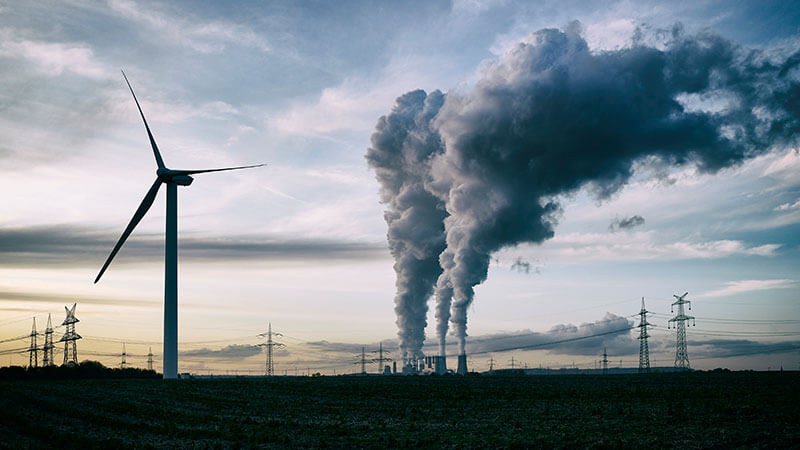Purdue research: More than green energy, wind turbines are cost-saving CO2 eliminators

WEST LAFAYETTE, Ind. — In a “game-changing” win against climate change, Purdue University research has discovered that wind turbines can not only provide the first clean-energy method to capture carbon dioxide, but they also can do so at a cost significantly lower than CO2 capture methods in use today.
Led by Luciano Castillo, the Kenninger Professor of Renewable Energy and Power Systems in the School of Mechanical Engineering, the study, recently published in the Journal of Renewable and Sustainable Energy, reveals the untapped potential of wind turbines to reduce CO2 — a global warming culprit produced by power generation from fossil fuels, industrial emissions, chemical and petroleum production, and agriculture.
“This is game-changing because this is the first time that wind turbines have been integrated with CO2capture technologies,” Castillo says. “The turbines’ ability to capture CO2 without emitting more CO2 or using additional energy proves they are a hidden treasure in the fight against climate change. And beyond that, wind energy doesn’t use water in the production of electricity, so it is indeed a major benefit to combat climate change.”
In work funded with $2.8 million from the Office of Naval Research, Castillo’s team found that wind turbines can increase the effectiveness of existing direct air capture (DAC) technologies that extract CO2 directly from the atmosphere anywhere. DAC technology is critical because a lot of CO2 is produced by widespread sources like agriculture, transportation and exhaust from buildings and cannot be captured at the point of emission, as is the case with many industrial emissions.
All current DAC methods are very costly and, ironically, require energy that generates CO2. Current costs for capturing CO2 using DAC range from $100-$600 per metric ton, according to the National Academies of Sciences, Engineering and Medicine. That per-ton cost adds up quickly given that, in 2022, the U.S. Energy Information Administration reported that U.S. utility-scale electric power plants alone emitted about 1.65 billion metric tons of CO2.
Wind turbines, as the Castillo team’s research demonstrates, not only produce clean, less expensive energy, they also increase the effectiveness of DAC technologies. Using novel simulations and carefully collected data from diverse global locations, the Castillo team documented how wind turbines create a swirling effect in their wake as they spin. This swirling air gathers CO2 into the wake of the turbine, enabling efficient DAC. And the amount of CO2 captured in the study was dramatic.
“We found that the turbines bring CO2 closer to the Earth’s surface in surprisingly large amounts,” says Venkatesh Pulletikurthi, a postdoctoral mechanical engineering researcher working with Castillo. “CO2concentrations plummeted by 138 kilograms per meter. To put that in context, a single car emits about 8.9 kilograms of CO2 for every gallon of gasoline consumed.”
Castillo says that he is eager to promote the benefits of this discovery while advancing the technology.
“We want to share this groundbreaking research at Purdue which shows that wind energy can significantly contribute to capturing CO2 and fight climate change,” he says. “To build on that, we would like to build wind turbines using other renewable energy sources so that we can cleanly deploy new resilient energy sources that produce clean energy while we capture CO2 simultaneously.”
Castillo says he plans to widen the scope of his investigations into wind turbine CO2 capture.
“We strive to broaden this research by conducting tests of wind turbines across diverse geographical locations and scales, enabling real-time experiments that propel advancement in this method of addressing climate change.”
The researchers have disclosed their innovation to the Purdue Innovates Office of Technology Commercialization, which has applied for a utility patent through the U.S. Patent and Trademark Office to protect the intellectual property. Industry partners interested in developing or commercializing the work should contact Parag Vasekar, business development and licensing manager – physical sciences, at psvasekar@prf.org.
About Purdue University
Purdue University is a public research institution demonstrating excellence at scale. Ranked among top 10 public universities and with two colleges in the top four in the United States, Purdue discovers and disseminates knowledge with a quality and at a scale second to none. More than 105,000 students study at Purdue across modalities and locations, including nearly 50,000 in person on the West Lafayette campus. Committed to affordability and accessibility, Purdue’s main campus has frozen tuition 13 years in a row. See how Purdue never stops in the persistent pursuit of the next giant leap — including its first comprehensive urban campus in Indianapolis, the Mitch Daniels School of Business, Purdue Computes and the One Health initiative — at https://www.purdue.edu/president/strategic-initiatives.
Writer/Media contact: Amy Raley, araley@purdue.edu
Source: Luciano Castillo, castil63@purdue.edu